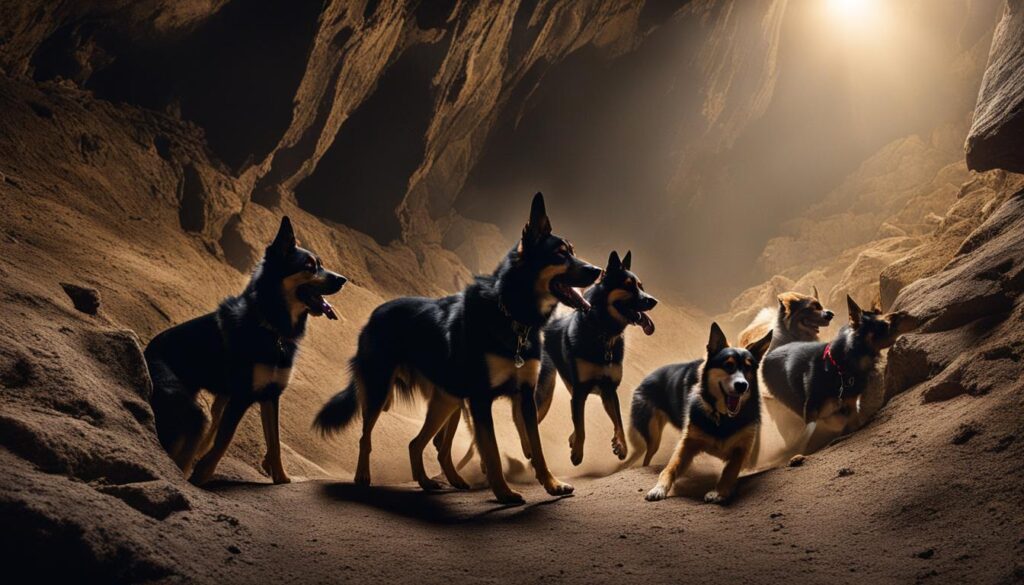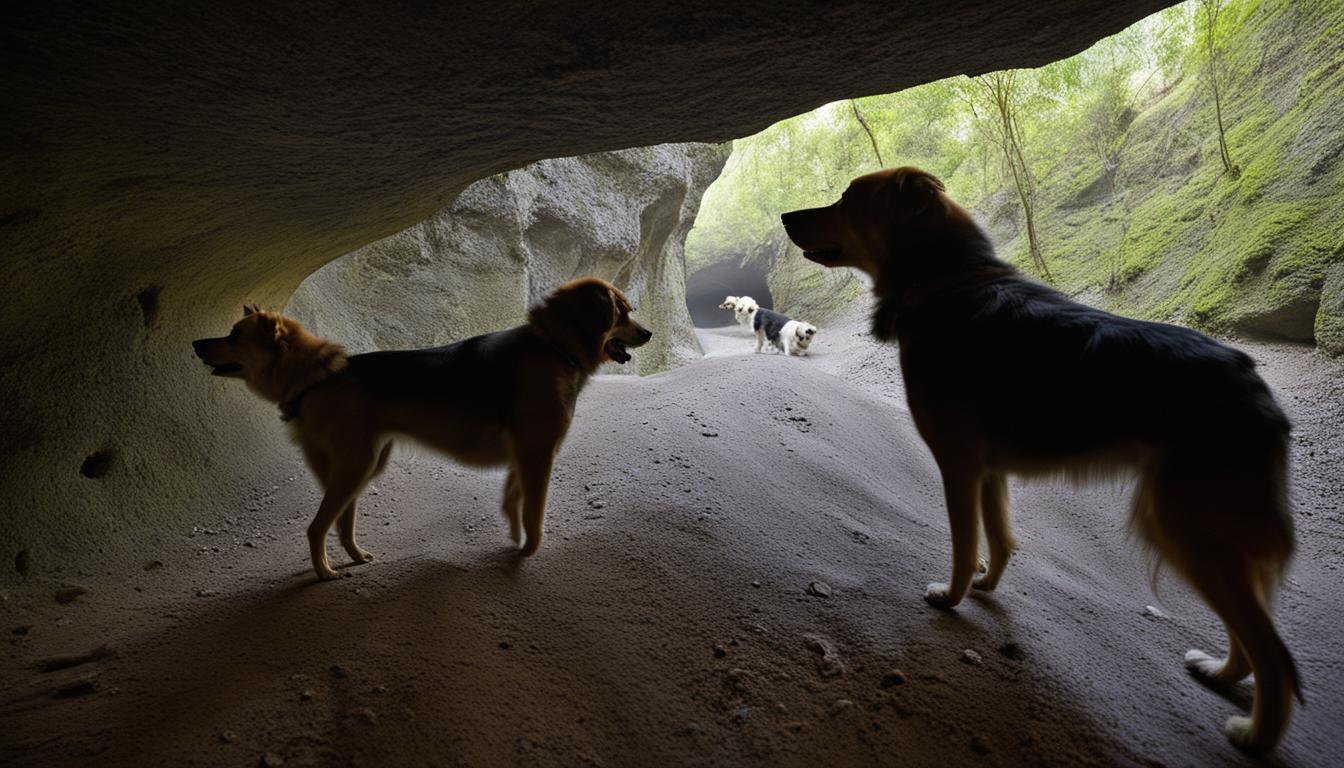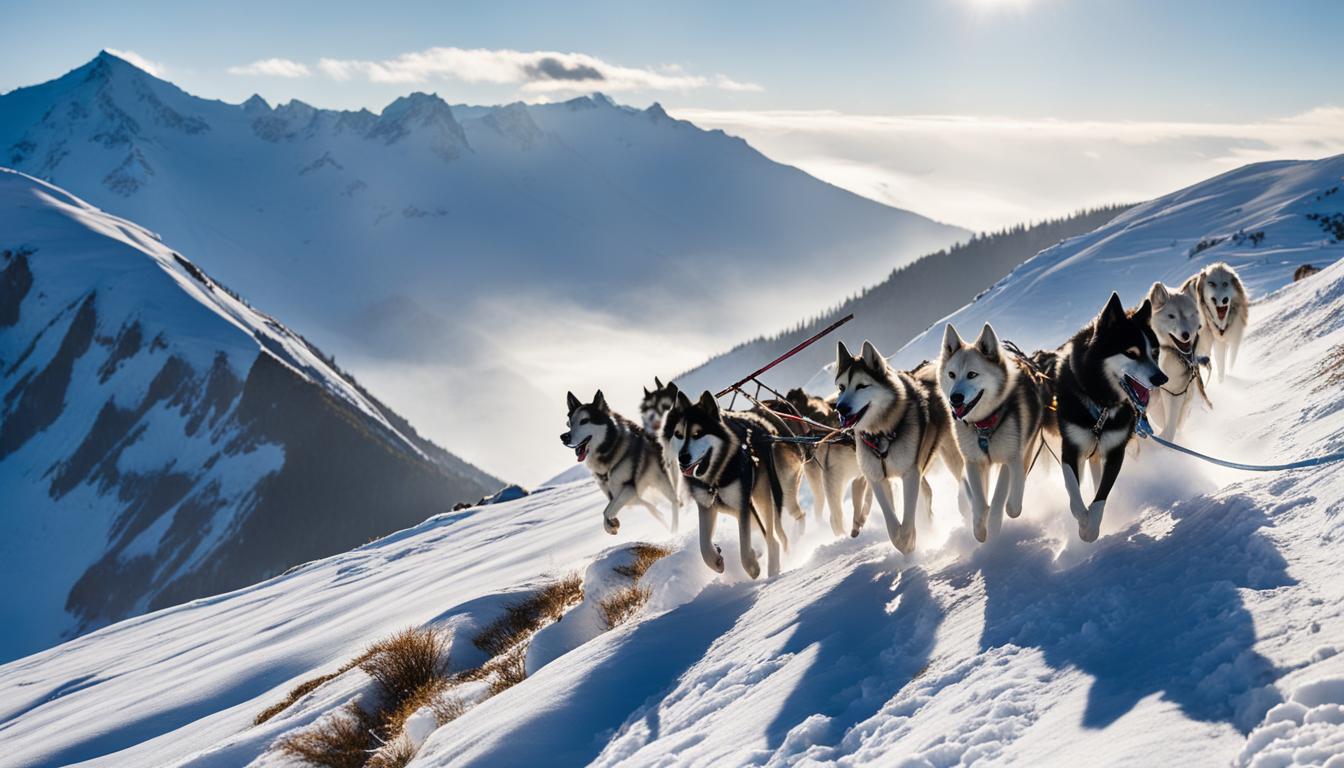Did you know that dogs have been playing a crucial role in remote cave exploration? These remarkable canines have been aiding speleologists in navigating the intricate underground systems, using their keen sense of smell and exceptional agility to uncover the hidden secrets tucked away in remote caves.
Key Takeaways
- Dogs are valuable companions in navigating underground cave systems.
- The historical significance of dogs in cave exploration spans centuries.
- These canines have the unique ability to detect hidden caves.
- Dogs play a crucial role in paleoclimatology research.
- The stories of dogs in remote cave exploration are filled with thrilling adventures.
The Historical Significance of Dogs in Cave Exploration
The rich history of cave exploration is intertwined with the presence of canine companions. For centuries, dogs have accompanied humans on expeditions into the depths of remote caves, adding to the excitement and aiding in the exploration process. These faithful and skilled companions have been trusted guides in historic cave journeys, supporting spelunkers in their quest to uncover hidden wonders.
From the Native Americans who first explored Mammoth Cave in Kentucky to modern-day adventurers, dogs have played an integral role in cave exploration. Their innate abilities, such as keen senses and agility, have made them indispensable companions in navigating the challenging terrains and intricate underground systems. Whether it is squeezing through tight passages or traversing treacherous drops, canines have fearlessly ventured where humans cannot easily follow.
“Dogs have been vital partners in cave exploration throughout history, known for their unwavering dedication and unmatched abilities,” says Dr. Sarah Carter, a renowned speleologist. “Their presence not only provides practical assistance but also adds to the rich tapestry of cave exploration, creating unforgettable stories of collaboration and discovery.”
The historical significance of dogs in cave exploration extends beyond their physical contributions. Their unwavering loyalty and companionship have fostered strong bonds with explorers, providing emotional support during arduous expeditions. Stories of these brave and resilient animals have been passed down through generations, inspiring future generations of explorers to continue the tradition of canine companions in subterranean expeditions.
The Cultural Influence of Dogs in Cave Exploration
The cultural impact of dogs in cave exploration cannot be overlooked. Paintings, sculptures, and ancient artifacts depict the close relationship between humans and dogs during these adventures. Additionally, folklore and legends often recount tales of heroic canines who guided explorers through treacherous caves, further cementing their place in the history of subterranean exploration.
| Historic Cave Journeys | Canine Companions |
|---|---|
| Mammoth Cave, Kentucky | Native American tribes relied on dogs to explore the vast cave system, mapping its intricate networks. |
| Cueva de las Manos, Argentina | Dogs accompanied early cave dwellers, providing protection and aiding in hunting. |
| Fingal’s Cave, Scotland | Explorers navigated the unique basalt columns with the assistance of their loyal canine companions. |

The bond between humans and dogs in cave exploration continues to this day. These remarkable animals leave an indelible mark on the exploration of remote caves, both in terms of practical support and cultural significance. As we delve further into the secrets hidden within the earth, let us not forget the invaluable contributions and storied history of our faithful canine companions.
The Role of Dogs in Uncovering Hidden Caves
When it comes to the exploration of underground caves, canines are reliable and essential partners. Their unique abilities allow them to navigate the challenging terrain, making them adept at guiding spelunkers and uncovering hidden caverns. As spelunkers venture deep into the unknown, dogs play a paramount role in their quest to uncover the secrets hidden beneath the Earth’s surface.
Canines exploring underground caves bring their acute sense of smell to the forefront, detecting the faint air currents and changes in the underground environment that might indicate the presence of a hidden cave system. These four-legged explorers act as guides, leading spelunkers through treacherous passages that might otherwise go unnoticed. With their keen senses and unwavering focus, dogs are invaluable assets in the discovery and mapping of intricate cave systems.
Dogs guiding spelunkers through underground caves often encounter tight spaces and challenging obstacles. Their agility and ability to traverse these obstacles with ease make them indispensable in the exploration process. These brave companions fearlessly accompany their human partners, crossing treacherous drops and rappelling down rock faces to reach remote and unexplored locations. Through their unwavering dedication and determination, these dogs help push the boundaries of exploration and expand our understanding of the hidden wonders that lie beneath the surface.
| Canine Abilities in Cave Exploration | Benefits in Cave Discovery |
|---|---|
| Keen sense of smell | Detects faint air currents and changes in the underground environment |
| Agility and ability to traverse challenging terrains | Guides spelunkers through tight spaces and difficult obstacles |
| Fearlessness and unwavering dedication | Accompanies explorers in reaching remote and unexplored locations |
Through their exceptional capabilities, these dogs contribute significantly to the exploration of hidden caves. As the bond between humans and canines continues to strengthen, the partnership in discovering the secrets of the underground world becomes even more fruitful.
Dogs as Partners in Paleoclimatology Research
In addition to their role in uncovering hidden caves, dogs have also become invaluable partners in the field of paleoclimatology research. With their keen sense of smell and ability to navigate treacherous cave environments, these canines aid speleologists in collecting valuable data that provides insights into past climates.
One of the key contributions of dogs in paleoclimatology research is their ability to retrieve stalactite and stalagmite samples from deep within caves. These mineral formations contain valuable information about temperature, rainfall, and atmospheric conditions from centuries ago. By carefully analyzing the layers and growth patterns of these formations, researchers can reconstruct climatic conditions and gain a deeper understanding of how our planet has changed over time.
Furthermore, dogs play a critical role in guiding scientists through the intricate cave systems, ensuring safe and efficient exploration. With their acute sense of smell, they can detect subtle changes in air currents that indicate the presence of hidden passages. Their agility allows them to traverse narrow and challenging spaces, enabling researchers to access areas that would otherwise be inaccessible.
The Benefits of Dogs in Paleoclimatology Research
The presence of dogs in paleoclimatology research brings several benefits. Their assistance in retrieving stalactite and stalagmite samples eliminates the need for complex and often risky human extraction techniques. Moreover, dogs can cover a larger area in a shorter period, enhancing the efficiency of data collection and research efforts. Their ability to guide speleologists through complex cave systems also minimizes the risk of getting lost or injured, ensuring the safety of both humans and canines.
Through their unique abilities and unwavering dedication, dogs have proven to be indispensable partners in paleoclimatology research. Their contributions not only advance our understanding of past climates but also highlight the remarkable potential of canine roles in underground adventures.
| Benefits of Dogs in Paleoclimatology Research | Explanation |
|---|---|
| Efficient sample retrieval | Dogs aid in collecting stalactite and stalagmite samples, eliminating the need for complex human extraction techniques. |
| Increased data collection | The agility and speed of dogs enable them to cover larger areas, enhancing the efficiency of data collection efforts. |
| Safe exploration | Dogs guide speleologists through complex cave systems, reducing the risk of getting lost or injured. |

“The contributions of dogs in paleoclimatology research cannot be overstated. Their sense of smell, agility, and unwavering dedication make them invaluable partners in uncovering the secrets of our planet’s past climates.” – Dr. Elizabeth Moore, Paleoclimatology Researcher
The Thrilling Adventures of Dogs in Remote Cave Exploration
Embarking on remote cave exploration is no easy feat. The darkness, the labyrinthine tunnels, and the treacherous terrain make it a daunting task for any adventurer. But for dogs, these challenges are just another exciting adventure waiting to unfold. With their unwavering courage and remarkable abilities, dogs have become indispensable companions in uncovering hidden caves and pushing the boundaries of exploration.
These four-legged explorers fearlessly navigate the most rugged terrains, rappelling down rock faces and crossing treacherous drops, all in pursuit of discovering unseen underground wonders. Their agility and keen senses make them ideal partners for spelunkers, who rely on their canine companions to lead the way through narrow passages and uncharted territories.
“Dogs have an incredible ability to help us uncover hidden caves that would otherwise remain undiscovered,” says Dr. Samantha Carter, a renowned speleologist. “Their acute sense of smell allows them to detect subtle changes in air currents, leading us to previously unknown caverns and expanding our knowledge of the underground world.”
The Unbreakable Bond between Humans and Dogs
It’s not just their physical prowess that makes dogs indispensable in remote cave exploration. It’s also the unbreakable bond they form with their human partners. The trust and companionship shared between humans and dogs are undeniable, providing emotional support and reassurance in the darkest and most challenging moments of exploration.
Whether it’s traversing precarious ledges or wading through underground rivers, dogs remain steadfast and loyal, offering a sense of comfort to their human counterparts. Their presence in these thrilling adventures not only enhances the exploration experience but also adds an element of companionship and joy to an otherwise arduous journey.
The Invaluable Contribution to Cave Exploration
Through their resilience and determination, dogs have made invaluable contributions to the field of cave exploration. Their ability to uncover hidden caves, navigate difficult terrains, and provide emotional support has expanded our understanding of the underground world and its historical and scientific significance. As we venture further into the depths of remote caves, these four-legged explorers will continue to accompany us, uncovering the secrets that lie beneath the surface.
| Dogs’ Contributions to Cave Exploration | |
|---|---|
| Detection of hidden caves | Canines use their keen sense of smell to identify faint air currents and changes in the underground environment, leading spelunkers to previously unknown caverns. |
| Navigation of challenging terrains | Dogs’ agility and physical abilities enable them to traverse tight spaces and difficult terrains, assisting researchers in exploring and mapping intricate cave systems. |
| Emotional support | The presence of dogs in remote cave exploration offers emotional support and companionship, enhancing the overall experience for human adventurers. |
The Scientific Importance of Dogs in Caves
Dogs play a crucial role in scientific expeditions to caves. Their unique abilities and unwavering dedication make them essential members of the exploration team. Not only do these canine companions provide companionship and support to researchers, but they also contribute in numerous ways to our understanding of cave ecosystems and their historical and scientific significance.
One of the key ways dogs aid in cave exploration is by assisting in the collection of scientific data. Whether it’s geological samples or archaeological artifacts, dogs are trained to locate and retrieve these essential pieces of information. Their keen sense of smell and ability to navigate challenging terrain allow them to access areas that may otherwise be difficult for researchers to reach.
Furthermore, dogs also play a vital role in detecting the presence of ancient remains. Their remarkable sense of smell enables them to identify the scent of decomposing materials, guiding researchers to areas of potential archaeological interest. By doing so, they contribute to our understanding of past civilizations and shed light on the history and cultural significance of these underground spaces.
Conclusion
Dogs have proven to be your ultimate partners in the exhilarating world of remote cave exploration. Their unique abilities and unwavering dedication make them essential members of your exploration team. Whether it’s aiding you in navigating the intricate underground systems or assisting in the collection of valuable scientific data, these canine companions have got your back.
As you continue to uncover the secrets hidden within remote caves, you can rely on your four-legged friends to aid you in every step of the way. Their keen sense of smell and agility in challenging terrains will guide you to undiscovered caverns and unexplored passages. Together, you will unravel the mysteries of the underground world.
With dogs aiding speleologists like you, remote cave exploration becomes an even more thrilling adventure. From rappelling down rock faces to braving treacherous drops, these furry explorers fearlessly accompany you, pushing the boundaries of what is possible. Their resilience and unwavering dedication expand your understanding of the underground world and its historical and scientific significance.
FAQ
How long have dogs been involved in cave exploration?
Dogs have been accompanying humans in cave exploration for centuries.
What abilities do dogs possess that make them valuable in cave exploration?
Dogs have a keen sense of smell, allowing them to detect hidden caves, and they are skilled at navigating tight spaces.
How do dogs contribute to paleoclimatology research in caves?
Dogs assist researchers in collecting stalactite and stalagmite samples that contain data about past climates.
What types of adventures do dogs experience in remote cave exploration?
Dogs participate in thrilling activities such as rappelling down rock faces and crossing treacherous drops.
What role do dogs play in scientific expeditions to caves?
Dogs assist in the collection of scientific data and provide support in locating unexplored passages and detecting ancient remains.
How significant are dogs in remote cave exploration?
Dogs have proven to be invaluable partners, contributing to expanding knowledge of the underground world and its historical and scientific significance.





